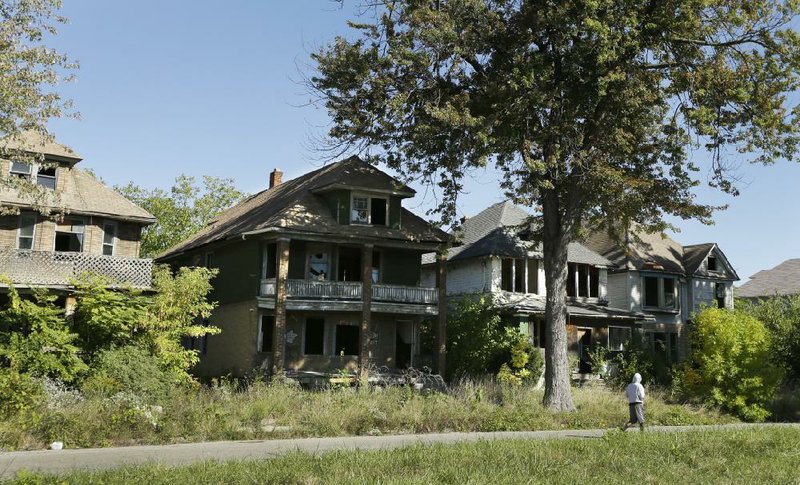Detroit’s latest plan to reduce its $18 billion debt load and exit bankruptcy guarantees police and firefighters at least 90 percent of their pensions while giving bondholders only about 20 percent of what they are owed.
The city’s debt-adjustment plan, filed Friday in U.S. Bankruptcy Court in Detroit, is built on $820 million in contributions from private foundations and the state. Those groups say no money will flow without a settlement that protects the city’s valuable art collection from liquidation by bondholders and other creditors.
Within hours of the plan being filed, the creditors that city officials must win over rejected the proposal, even as they continued talking in private. Unions and bond insurers both registered their displeasure.
“While we understand that favoring pensioners and discriminating against bondholders and other creditors might be politically popular, we believe this is contrary to bankruptcy law and will result in costly litigation that will hamper the city’s emergence from bankruptcy,” Steve Spencer, a financial adviser for bond insurer FGIC Corp., said in an emailed statement.
The filing opens a new, potentially more contentious phase of the biggest U.S. municipal bankruptcy. Unless confidential mediation sessions produce settlements, U.S. Bankruptcy Judge Steven Rhodes will be asked to approve the plan over objections from creditors, including unions.
“The proposed plan of adjustment is a gut punch to Detroit city workers and retirees,” the American Federation of State, County and Municipal Employees said in a statement. “Retirees cannot survive these huge cuts to the pensions they earned. The plan is unfair and unacceptable.”
Under the plan, the city’s retired general employees, represented by the trade union, wouldn’t get as much as police and firefighters.
If Rhodes approves the plan as is, the general workers would be forced to take 66 percent of their current pensions. If the workers voluntarily accept the proposal, they would get 74 percent, and police and firefighters 96 percent, according to the filing.
A committee approved by Rhodes to represent more than 23,500 retired city workers in the case also condemned the plan, claiming in a statement that the proposal would force 20 percent of current city retirees into poverty in the next 10 years.
The new plan offers less than what the city said last month that it would pay investors who hold two types of general-obligation bonds. The limited and unlimited versions of the bonds would be paid only 20 percent of about $539 million outstanding, down from a maximum of 31 percent and 48 percent respectively.
Bond insurers, who would be expected to pay any losses on the bonds they back, have sued the city, arguing that the debt is guaranteed by property taxes and should have a higher repayment priority than other creditors, such as retired city workers.
The city’s emergency financial manager, Kevyn Orr, said the $820 million contribution hinges on an “all in” deal.
“We need a settlement from everybody,” he said.
The foundations supplying the money are trying to protect the artwork in the city-owned Detroit Institute of Arts.
The institute’s building and artwork would be donated to the nonprofit that currently operates the museum as part of the restructuring proposal. In exchange, Detroit would get millions to bolster its pension plans.
The group of foundations with ties to the museum will raise $365 million for the pension plans, and the DIA Corp. will commit to raising another $100 million from donors. In addition, Michigan Gov. Rick Snyder is seeking $350 million from the state to add to the fund.
But a coalition of bond insurers have vowed to fight the proposal, seeking a sell off of city-owned artwork to pay off debts.
Snyder, a Republican who appointed Orr, said securing $350 million in state funding to reduce pension cuts and spin off the Detroit Institute of Arts is a work in progress. He’ll have to persuade the GOP-controlled Legislature to sign off, but Republicans are sensitive to the prospect of a Detroit bailout.
“Detroit’s comeback is underway,” Snyder said in a statement. “Kevyn Orr has submitted a thoughtful, comprehensive blueprint directing the city back to solid financial ground, a crucial step toward a fully revitalized Detroit.”
Snyder added: “There will be difficult decisions and challenges for all sides as this process moves forward. The state’s focus is on protecting and minimizing the impact on retirees, especially those on fixed, limited incomes, restoring and improving essential services for all 700,000 Detroit residents and building a foundation for the city’s long-term financial stability and economic growth.”
The proposal filed Friday doesn’t include any cash for creditors from a potential new source: a Great Lakes Water and Sewer Authority, which would take over responsibilities from the city. Detroit has said it wants to create the authority and then lease its water and sewer operations to it to boost creditor recoveries.
Under the plan, the city would fully repay water and sewer bonds, as well as other debt that’s backed by collateral.
Detroit filed for bankruptcy July 18 after decades of decline, saying it couldn’t pay creditors while also providing basic services. Orr set an aggressive timetable for the case, seeking to finish by this September, when he can be removed from his post by the City Council.
Once the center of the U.S. auto industry, Detroit has seen factory jobs dwindle in recent decades. During the U.S. financial crisis, General Motors Co. and Chrysler Group LLC went through bankruptcies of their own. Both companies have since reorganized and are thriving again, while the city continues to cope with broken streetlights, blighted neighborhoods and overstretched emergency services.
The plan is meant to cut debt and reinvest in the city, Orr said in a statement. Under the proposal, Detroit would spend $1.5 billion over 10 years on capital improvements, and equipment and technology upgrades. As much as $500 million of that would be spent in the next five years on blight removal in a city with tens of thousands of abandoned properties.
Rhodes initially must decide whether the proposal contains enough information for creditors to vote on it. He had said he expected the city to keep talking to creditors even after a plan was filed.
“Mediation won’t be over until every last single issue has been settled or decided by me,” Rhodes warned the parties this week during a court hearing. “Maybe even it will continue until the case is on appeal.”
In December, Rhodes found the city eligible for bankruptcy protection, overruling the unions that want the case dismissed. Earlier Friday, the unions and retired public workers won permission to take their challenge to the city’s eligibility directly to a federal appeals court, bypassing the District Court, possibly speeding up a resolution.
Orr’s plan would reduce benefits for some retirees who may have benefited from an annuity savings plan operated by the pension system. The optional savings plan boosted payouts by hundreds of thousands of dollars for some retirees who contributed their own money and reaped a guaranteed investment return, even in years when the pension fund lost money in the market.
Money paid from the pension fund to the annuity savings program from 1999 through 2012 would be put back in the fund. Orr didn’t divulge how much the restitution would cost the employees and retirees who may have received the payments, which totaled about $756 million from 1985 through 2007, according to city records.
The plan also places restrictions on the city’s two retirement programs and leaves open the door to changing their governing boards under a mediated settlement that includes Snyder and the Legislature. The pension board would be required to limit to 6.25 percent their expected returns on investment.
After a vote, creditors can raise further objections at a confirmation hearing. Rhodes will take the votes and the objections into account before deciding whether to confirm the plan. Bankruptcy law permits him to override a no vote through a process known as a cram-down.
Separately, the city has filed a lawsuit seeking to wipe out $1.4 billion in pension debt held mostly by European banks that was issued in 2005 by Mayor Kwame Kilpatrick’s administration to eliminate the city’s unfunded pension liabilities.
The city argued the so called pension obligation certificates of participation were illegal and do not have to be paid.
Information for this article was contributed by Steven Church, Dawn McCarty, Brian Chappatta, Mary Childs, Chris Christoff and Andrew Harris of Bloomberg News; by Corey Williams and staff members of The Associated Press; and by Matt Helms, Nathan Bomey and Brent Snavely of The Detroit Free Press.
Front Section, Pages 1 on 02/22/2014


